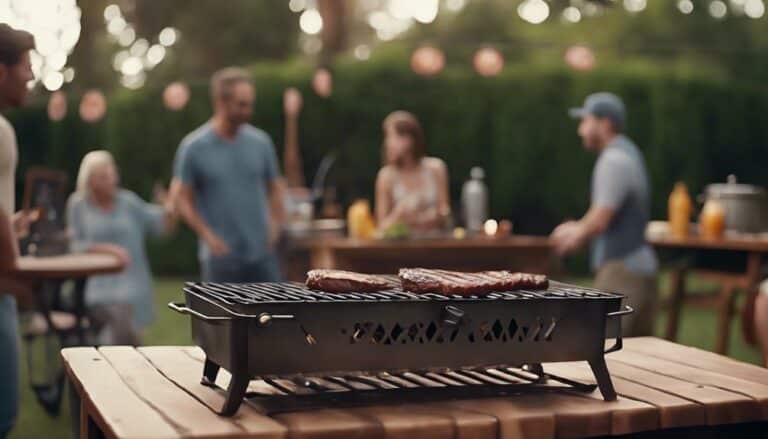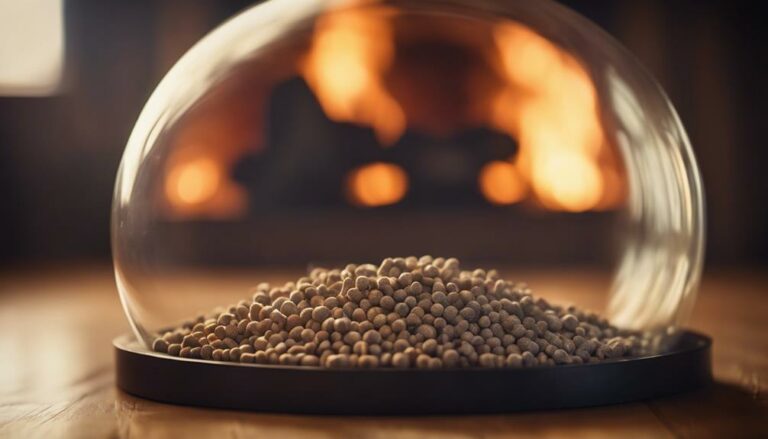The debate between charcoal and gas barbecuing encompasses a multitude of factors that extend beyond mere taste preferences and venture into the realm of health implications.
Table of Contents
Charcoal enthusiasts often laud the superior flavor and the high-heat searing capabilities of their grills, but may inadvertently overlook the potential health risks associated with the higher levels of carcinogens produced by this method.
Conversely, gas grilling aficionados point to the cleaner combustion process and the reduced environmental impact, yet must also consider the trade-offs in flavor and the limitations in temperature variance.
As we examine the dichotomy of these barbecuing techniques through a health-centric lens, we must carefully weigh the evidence on carcinogen exposure, air quality impact, and chemical additive concerns, among other critical factors.
The ensuing discourse is not merely academic; it has tangible ramifications on our well-being and culinary practices. In light of these considerations, it becomes paramount to navigate this intricate topic with a discerning eye, understanding that the choices we make at the grill could have a lasting impact on our health.
Key Takeaways
- Charcoal grilling leads to higher levels of carcinogenic HCAs and PAHs compared to gas grilling, making gas grilling a safer option in terms of carcinogen exposure.
- Gas grills emit fewer pollutants and contribute to cleaner air quality, while charcoal grills release harmful substances and have a higher carbon footprint.
- Charcoal grilling produces more smoke carrying hazardous chemicals like HCAs and PAHs, while gas grilling produces less smoke and fewer harmful compounds.
- Charcoal grilling enhances meat flavor and retains natural juices, but gas grills offer convenience, superior temperature control, and immediate cooking after ignition.
Carcinogen Exposure Levels
When comparing charcoal and gas barbecuing, it is crucial to note that the former typically leads to higher levels of carcinogenic heterocyclic amines (HCAs) and polycyclic aromatic hydrocarbons (PAHs) due to the direct contact of meat with an open flame and the smoke generated from dripping fats. HCAs form when amino acids and creatine, substances found in muscle meat, react at high temperatures. Charcoal grilling often reaches these temperatures, thus increasing the likelihood of HCA formation.
Likewise, PAHs are introduced into the food through smoke, which envelops the meat as fats and juices from the grill food combust upon contact with the hot charcoal. These compounds adhere to the surface, potentially turning a culinary delight into a health risk.
Gas grilling, on the other hand, often allows for more precise temperature control and produces fewer carcinogens compared to its charcoal counterpart. This is due to the reduced flare-ups and lower intensity of direct heat, which minimizes charring – a significant source of these harmful chemicals.
It is imperative for aficionados of grilled cuisine to recognize the intrinsic health risks associated with high-temperature grilling and the carcinogenic potential of certain methods. While neither technique is without its drawbacks, gas grilling is generally associated with a safer cooking environment concerning carcinogen exposure.
Air Quality Impact
Turning our attention to the air quality impact of barbecuing, it is critical to compare the emissions produced by charcoal and gas grills.
Charcoal grills emit a larger quantity of smoke and particulate matter, raising concerns over the inhalation of these byproducts, which can adversely affect respiratory health.
Conversely, gas grills are known to emit fewer pollutants, contributing to a cleaner air quality and a reduced environmental burden.
Emission Types Compared
Charcoal grilling is associated with the release of harmful substances, such as high levels of particulate matter, volatile organic compounds, carbon monoxide, and soot, which contribute negatively to air quality compared to the cleaner combustion process of gas grilling. When emission types compared, the carbon footprint of charcoal grills carbon is significantly higher due to the incomplete combustion of the charcoal briquettes.
- Health Risk: Charcoal emits carcinogens that endanger our health, overshadowing the joy of traditional barbecuing.
- Environmental Cost: The carbon footprint left by charcoal grilling exacerbates the climate crisis, betraying our responsibility to the planet.
- Inconsistency: Unlike the consistent and even heat of gas grills, charcoal contributes to uneven cooking and irregular emissions.
Adopting gas grilling aligns with a mastery of both culinary technique and environmental stewardship.
Smoke Inhalation Concerns
Building on the discussion of emissions, it is crucial to consider the specific health implications of smoke inhalation from charcoal grilling and its impact on air quality.
Charcoal grilling releases smoke that carries hazardous chemicals such as heterocyclic amines (HCAs) and polycyclic aromatic hydrocarbons (PAHs). These substances are known for their carcinogenic properties, increasing the risk of cancer among frequent grillers and bystanders alike. Moreover, the smoky flavor, a signature of charcoal-grilled foods, is a byproduct of these harmful compounds.
In contrast, gas grilling is associated with fewer smoke inhalation concerns. It produces less smoke and, consequently, fewer HCAs and PAHs, representing a healthier alternative for those who prioritize air quality and wish to minimize their exposure to toxic emissions.
Meat Flavor and Retention
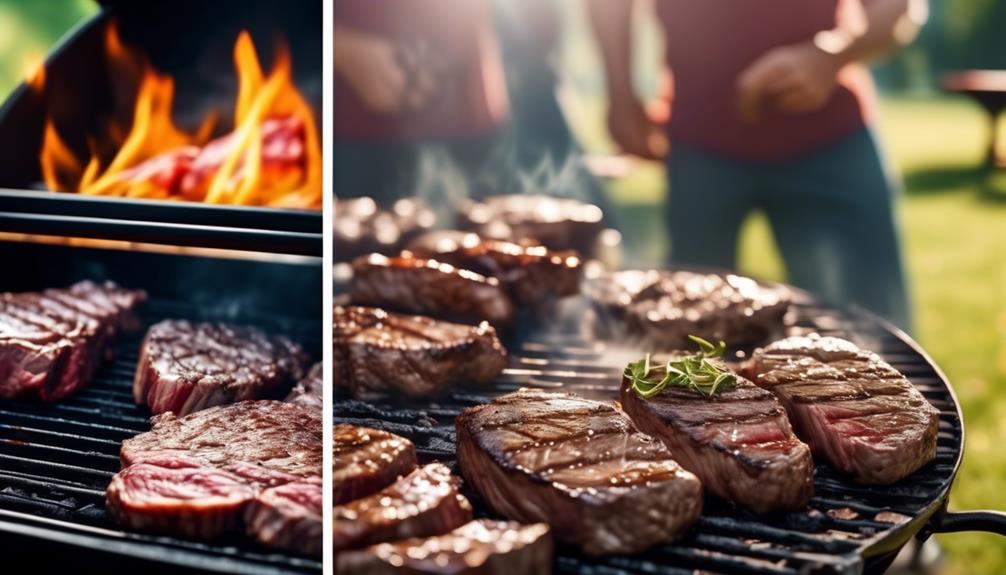
When it comes to barbecuing, the choice of using a charcoal grill can significantly enhance the meat’s flavor due to its ability to impart a smoky taste and retain the meat’s natural juices. Charcoal grills have long been celebrated for their contribution to meat flavor and retention. The intricate dance of fire and smoke gives meat a complexity of taste that is deeply satisfying and often unachievable with other cooking methods.
The high heat of charcoal grilling sears meat quickly, creating a deliciously caramelized crust that is the hallmark of expertly barbecued leaner cuts of meat. This crust not only adds a depth of flavor but also helps to lock in juices, ensuring that each bite is as succulent as the first.
Consider the following points that highlight the advantages of charcoal grilling:
- The smoky aroma and taste that charcoal grilling imparts to meats can elevate even the simplest of recipes to a gourmet experience.
- By preserving the natural juices, charcoal grills maintain the integrity of the meat’s texture, preventing it from drying out.
- The art of mastering charcoal grilling is a rite of passage for connoisseurs, affirming their commitment to the craft of exquisite barbecuing.
Cooking Temperature Control
Mastering the art of cooking temperature control is a critical factor in determining the quality and safety of barbecued foods, with each type of grill offering distinct advantages in this domain.
Charcoal grills excel in reaching high temperatures, which is paramount for achieving a coveted sear that imparts a rich, caramelized crust on meats. This intense heat is a hallmark of charcoal barbecuing, yet it necessitates a nuanced approach to ensure foods reach the proper cooking temperature without charring, which can compromise both taste and health.
Conversely, gas grills are celebrated for their convenience and superior temperature control, enabling grillers to start cooking almost immediately after ignition. The ability to adjust the flame with precision allows for an even heat distribution, creating an optimal environment for cooking a variety of foods to perfection. This precise control is especially beneficial when preparing delicate items that could be overpowered by the intense smokiness of charcoal or when a low and slow cooking method is desired.
Achieving the perfect barbecue experience hinges on the griller’s ability to manage the cooking temperature effectively. Whether using charcoal or gas, understanding the characteristics of each grill type is essential for culinary success and the production of flavorful, health-conscious meals.
Chemical Additive Concerns
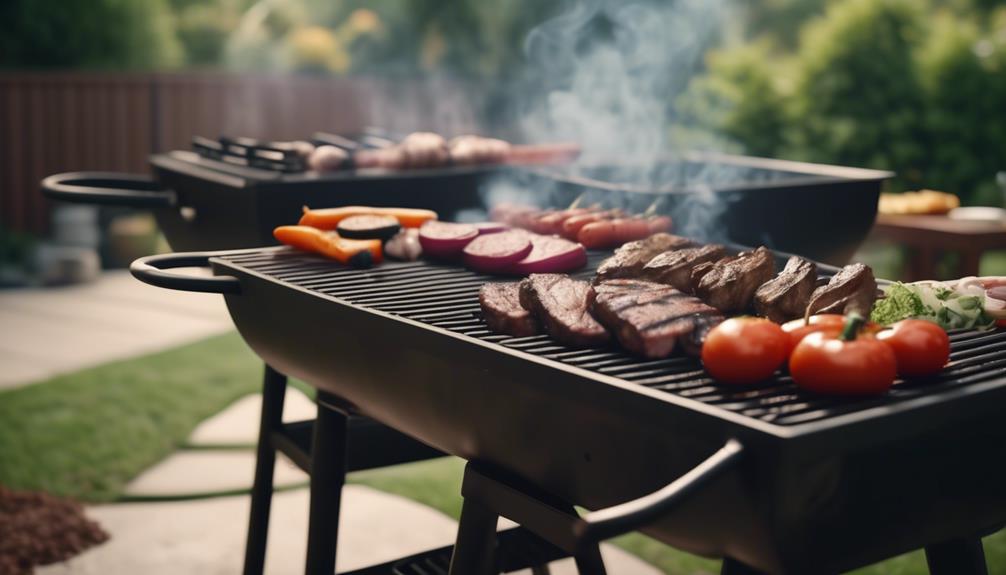
Amidst the smoky allure of charcoal grilling, health concerns arise due to the presence of chemical additives and the formation of hazardous compounds during high-temperature cooking. Charcoal briquettes often contain chemical additives that can volatilize and contaminate the food, potentially leading to adverse health effects. The allure of charcoal grilling’s smoky flavor must be weighed against these chemical additive concerns.
- Charcoal briquettes may include fillers and binders that, when incinerated, release toxic chemicals.
- Gas grills contain fewer of these additives, offering a cleaner combustion process.
- Proper disposal of used ashes is paramount as they can contain harmful chemical residues.
For those seeking to master the art of healthy grilling, understanding the implications of these additives is crucial. Gas grilling is considered the healthier option, not only because it produces fewer carcinogens but also due to its lower environmental impact. However, for purists dedicated to charcoal, mitigation strategies such as choosing additive-free lump charcoal and thoroughly managing cooking temperatures can reduce these risks.
Mastery of grilling techniques thus involves not just the culinary aspect but also a keen awareness of the health implications associated with different fuel sources.
Fat Drip Combustion Effects
While the chemical additives in charcoal are a significant concern, the effects of fat dripping onto hot coals present another health consideration for barbecue enthusiasts.
Charcoal grills pose a particular risk as fat from meat can combust upon contact with the smoldering embers. This fat drip combustion can generate smoke rich in polycyclic aromatic hydrocarbons (PAHs) and heterocyclic amines (HCAs), both of which are recognized for their carcinogenic properties. The allure of charcoal barbecuing often lies in the smoky flavor imparted to the meat; however, it is this very smoke that carries the harmful compounds.
Gas grills, comparatively, may offer more control over the heat source, potentially reducing the incidence of fat drip combustion. By maintaining a proper cooking temperature and preventing direct exposure of meat to open flame, gas grills can mitigate the formation of PAHs and HCAs. Nevertheless, the risk is not entirely eliminated, as flare-ups can occur and fat can vaporize into smoke even in gas grill models.
Mastering the grilling process involves not only achieving the desired culinary outcome but also minimizing health risks. Understanding and properly managing fat drip combustion effects are therefore essential practices for those seeking to enjoy grilled meats responsibly.
Grilling Time and Nutrient Loss
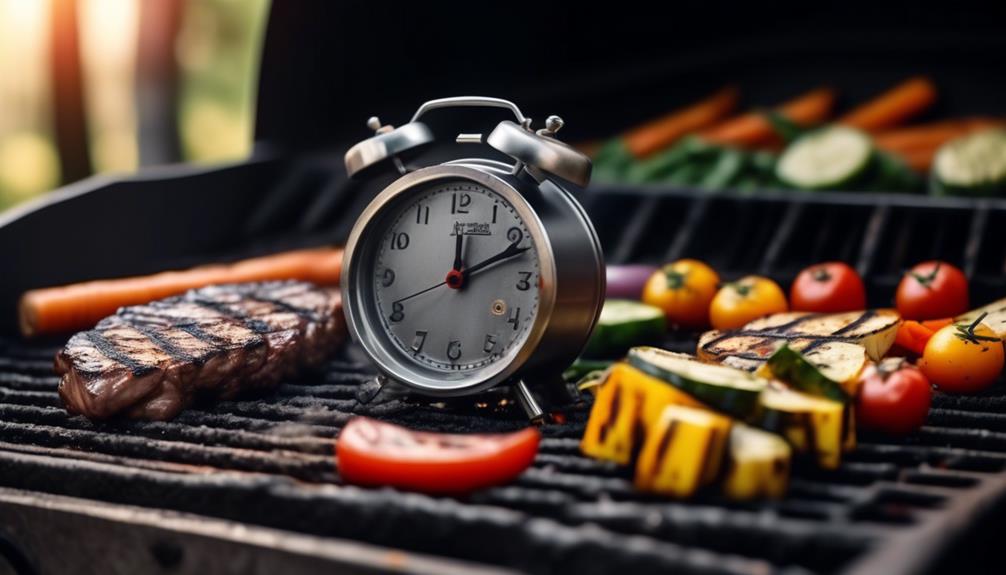
The duration of grilling and the subsequent nutrient retention in food are significantly influenced by the choice between charcoal and gas barbecuing.
While the prolonged heating period and higher temperatures associated with charcoal grills may lead to greater nutrient degradation, gas grills offer a distinct advantage with their rapid ignition and precise temperature control, potentially minimizing nutrient loss.
It is imperative for health-conscious individuals to consider these factors when selecting a grilling method, as they directly affect the nutritional quality of grilled foods.
Grilling Speed Impact
When considering the impact of grilling speed on both time efficiency and nutrient retention, it is clear that charcoal and gas grilling methods offer differing advantages and drawbacks.
Charcoal grills require a patience-testing preheat period, which extends the total time it takes to grill. This longer cooking time, while it may degrade some nutrients, is also responsible for that coveted, deep smoky flavor.
The quick preheat time of gas grills caters to our fast-paced lifestyles, keeping nutrient loss to a minimum.
Charcoal enthusiasts might argue that the waiting game is a small price for that authentic barbecue taste, despite the higher potential for nutrient diminishment.
In contrast, the expediency of gas grilling supports modern health-conscious living, favoring both time management and nutrient preservation.
Experienced grillers will weigh these factors carefully, considering both the grilling speed impact and their personal priorities.
Nutrient Retention Differences
Grilling methods, particularly the choice between charcoal and gas, play a significant role in determining the level of nutrient retention in cooked foods.
When grilling meat or other foods, the temperature and duration of cooking are crucial factors that influence the preservation of essential nutrients.
Charcoal grilling, often involving longer exposure to high temperatures, can lead to greater nutrient degradation.
On the other hand, gas grilling allows for more precise temperature control and typically requires shorter grilling times, which is conducive to better nutrient preservation.
Consequently, for those aiming to maintain a higher nutritional value in their grilled foods, gas grills may offer a distinct advantage.
It is imperative to consider these variables—heat control, grilling time, and cooking temperature—to optimize nutrient retention during the grilling process.
Smoke Inhalation Differences
Understanding the differences in smoke inhalation between charcoal and gas barbecuing is crucial, as it directly impacts both personal health and environmental considerations.
Charcoal grills, while cherished for their smoky flavor, pose significant health risks due to their production of harmful substances like heterocyclic amines (HCAs) and polycyclic aromatic hydrocarbons (PAHs). These cancer-causing compounds form when meats are cooked at high temperatures, which is common in the intense heat of charcoal barbecuing.
Gas grills start with an advantage, as they produce fewer carcinogens and less smoke. This reduction is primarily due to the lower temperatures and cleaner burning characteristics of propane or natural gas compared to charcoal. Moreover, gas grilling is often seen as the healthier choice for those looking to mitigate the risks associated with smoke inhalation.
To evoke an emotional response in the audience, consider the following:
- The aroma of a charcoal grill may evoke nostalgia, but at what cost to our health and the environment?
- Imagine a future with fewer health risks, where gas grilling minimizes our exposure to carcinogens.
- Picture a family gathering where the joy of outdoor cooking isn’t overshadowed by concerns over air quality and smoke inhalation.
Informed grill enthusiasts must weigh these smoke inhalation differences when choosing between charcoal and gas. Mastery over one’s health and environmental impact becomes achievable through educated decision-making in our barbecuing preferences.
Grill Maintenance and Cleanliness
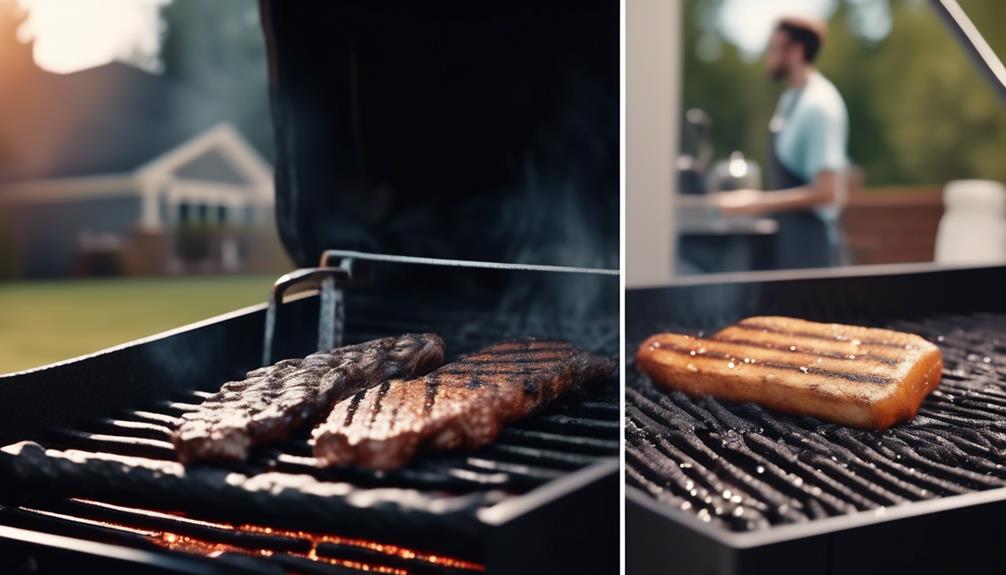
Regular maintenance and thorough cleanliness are pivotal to ensuring the longevity and performance of both charcoal and gas grills. Grill maintenance and cleanliness not only contribute to safer cooking conditions but also enhance the flavors of the food prepared. For charcoal grills, it is essential they be emptied of their used ashes and debris to maintain optimal airflow, which is critical for efficient burning and temperature control. On the other hand, gas grills require that the propane tank is properly connected and checked for leaks, and that the burner tubes and ignition system are clear to prevent uneven heating or failure to ignite.
To make the maintenance process clearer, here is a concise table outlining key tasks:
| Maintenance Area | Charcoal Grill | Gas Grill |
|---|---|---|
| Grate Cleaning | After each use, to prevent residue build-up | After each use, to prevent flare-ups |
| Internal Cleaning | Regularly remove ash to ensure proper airflow | Clean burner tubes and ports for even heat |
| Component Inspection | Replace worn parts such as grill brushes | Check connections and replace damaged parts |
Each part of the grill, from the grates to the exterior finish, requires attention to uphold a high standard of grill maintenance and cleanliness. By adhering to these practices, aficionados can guarantee that their grilling equipment remains in prime condition, ready to deliver the exceptional dining experiences they strive for.
Potential Burn Risks
When it comes to barbecuing, both charcoal and gas grills require vigilant attention to safety, as they inherently present numerous potential burn risks to users.
Charcoal grills, with their open flames and hot coals, can easily become a hazard if not managed properly. They demand a careful approach when spreading coals to heat the grill evenly, as well as when disposing of ashes post-cooking since embers can remain hot for hours and lead to unexpected burns.
Gas grills, while offering more control over the cooking temperature, can still reach higher temperatures that pose a risk. The potential burn risks increase substantially during the assembly and routine maintenance, particularly when connecting or replacing propane tanks. The metal surfaces of the grill, along with additional features like rotisserie kits and infrared burners, maintain high levels of heat long after use.
To underscore the importance of burn safety, consider the following potential consequences:
- Severe Skin Burns: Direct contact with grill surfaces or hot coals can lead to significant injuries requiring medical attention.
- Ignition of Clothing: Loose garments can catch fire if they come too close to the grill.
- Explosions: Incorrect handling of gas canisters can result in dangerous explosions.
In mastering the art of barbecuing, one must prioritize safety to protect against these serious risks.
Polycyclic Aromatic Hydrocarbons
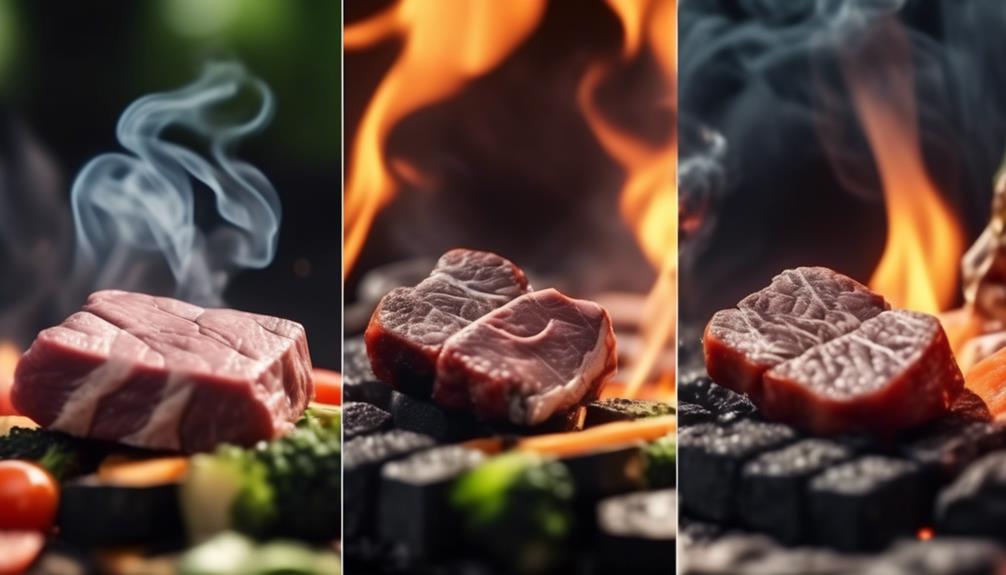
When considering the health implications of barbecuing, the formation of Polycyclic Aromatic Hydrocarbons (PAHs) is a critical factor. These compounds, known for their carcinogenic properties, are more prevalent in the smoke produced by charcoal grills, especially when fat from meat drips onto hot coals.
Assessing the health impact of PAHs is essential, as it informs safer grilling practices and underscores the comparative benefits of using gas grills, which generate fewer PAHs.
PAH Formation Factors
Understanding the factors influencing PAH formation is crucial when considering the health implications of charcoal versus gas barbecuing. Polycyclic Aromatic Hydrocarbons (PAHs) are a group of chemicals known for their potential carcinogenic properties, which are often a byproduct of grilling meats at high temperatures. When grilling, several factors can affect the levels of PAHs produced:
- High Temperature: Searing meat over an intense flame increases the risk of PAH formation.
- Fat Drippings: When fat from the meat drips onto the coals, it generates smoke laden with PAHs.
- Charcoal Type: The choice of charcoal can influence PAH levels, with certain types contributing more to PAH formation.
Grill enthusiasts must approach charcoal grills with an understanding of these PAH formation factors to mitigate health risks.
Health Impact Assessment
The presence of Polycyclic Aromatic Hydrocarbons (PAHs) in the smoke from charcoal grills poses a significant health risk, necessitating a thorough Health Impact Assessment to better understand the implications of these carcinogens on long-term well-being.
Delving into the Charcoal vs Gas debate reveals that the high temperatures charcoal grills reach can exacerbate the formation of PAHs. This factor tips the scales in favor of gas grilling in any pros and cons list concerned with healthful cooking practices.
A comprehensive Health Impact Assessment underscores the advantage of gas grilling, which is associated with a reduction in PAH-related health risks.
To minimize harmful exposure while using charcoal grills, adopting safer grilling techniques is imperative, enhancing the qualitative experience without compromising health standards.
Heterocyclic Amines Formation
Grilled meats, while often a staple at family gatherings and social events, can pose health risks due to the formation of heterocyclic amines (HCAs), particularly when cooked at high temperatures. When muscle meats, such as beef, pork, fish, or poultry, are exposed to the intense heat of a grill, HCAs form through a chemical reaction between the meat’s amino acids and creatine. It is an issue that concerns both charcoal and gas grilling enthusiasts, as the risk does not discriminate based on the heat source.
The conversation around HCAs is not only a matter of chemistry but also of health consciousness. Consider the following points:
- HCAs have been linked to an increased risk of certain cancers, stirring unease among those who cherish their barbeque traditions.
- The allure of a perfectly charred steak is shadowed by the potential introduction of carcinogens into our cherished meals.
- Knowledge of HCA formation empowers individuals to make informed choices, potentially shaping a new culture of safer grilling practices.
To mitigate these risks, it is advisable to use lower temperatures when grilling and to marinate meats, which can be effective strategies in reducing HCA formation. The mastery of grilling should thus embrace both the art of flavor and the science of health.
Which Barbecuing Method is Most Suitable for Traveling with Compact BBQ Tools?
When it comes to traveling with compact BBQ tools, the best barbecuing method would be grilling. Grilling is the most suitable method for compact bbq tools for traveling, as it is quick, easy, and requires minimal preparation. Additionally, grilling allows for a more portable and convenient cooking experience while on the go.
Overall Cardiovascular Health
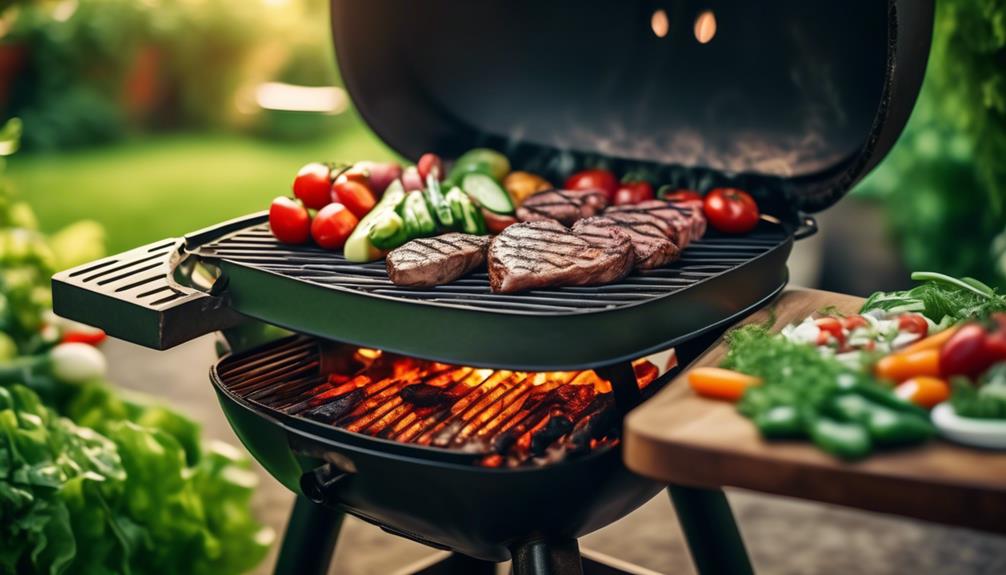
While discussing the chemical risks associated with barbecuing, it is equally important to consider the broader implications of diet and lifestyle choices on overall cardiovascular health. As the grilling season heats up, enthusiasts often debate the merits of charcoal vs gas grilling. Yet, regardless of the heat source, the emphasis should invariably shift to the quality and preparation of food, which plays a pivotal role in promoting heart health.
A diet that prioritizes heart-healthy choices can be easily accommodated in a barbecue context. Incorporating a variety of fruits and vegetables, along with whole grains and lean proteins, can transform a traditionally indulgent affair into a cardiovascular boon. Physical activities that might surround barbecuing events, such as setting up the equipment, playing outdoor games, or even standing and socializing, contribute to the recommended physical activity that bolsters heart function.
Moreover, the act of grilling itself can be seen as a stress-reducing leisure activity, provided it is approached with mindfulness and enjoyment rather than as a stressful task. Regularly monitoring health markers such as blood pressure, cholesterol levels, and blood sugar, while avoiding tobacco and excessive alcohol, are critical behavioral pillars that support overall cardiovascular health beyond the choice of charcoal or gas as a grilling medium.
Frequently Asked Questions
Is It Healthier to Grill With Gas or Charcoal?
Grilling with gas typically offers a healthier option by minimizing chemical exposure and emission differences, despite a potential compromise on flavor impact and cooking temperatures achievable with charcoal.
What Type of BBQ Is the Healthiest?
In the quest for the healthiest BBQ, one must weigh flavor differences against emission concerns, ensure optimal cooking temperatures, and minimize meat carcinogens. Gas BBQ emerges superior, balancing gourmet aspirations with health-conscious prudence.
What Is the Healthiest Way to Grill?
The healthiest grilling practices incorporate advanced techniques such as selecting lean meats, utilizing antioxidant-rich marinades, meticulously managing cooking temperatures to prevent charring, and employing precise timing to preserve nutritional content and flavor.
What Is the Healthiest Fuel for Grills?
While some may argue that flavor differences are subjective, the healthiest fuel for grills is gas, due to lower cooking temperatures reducing carcinogen formation, decreased environmental impact, and fuel costs over time.
Conclusion
In the tapestry of culinary arts, charcoal and gas grilling represent dual paths within the realm of barbecuing, each weaving its distinct patterns of flavor and health implications.
While the former etches a bold smokiness at the expense of air purity and potential carcinogenic threads, the latter offers a cleaner environmental footprint, albeit with less intensity in the gastronomic narrative.
Thus, the epicurean artist must choose their medium wisely, balancing the quest for epicurean delight with the parchment of well-being.







